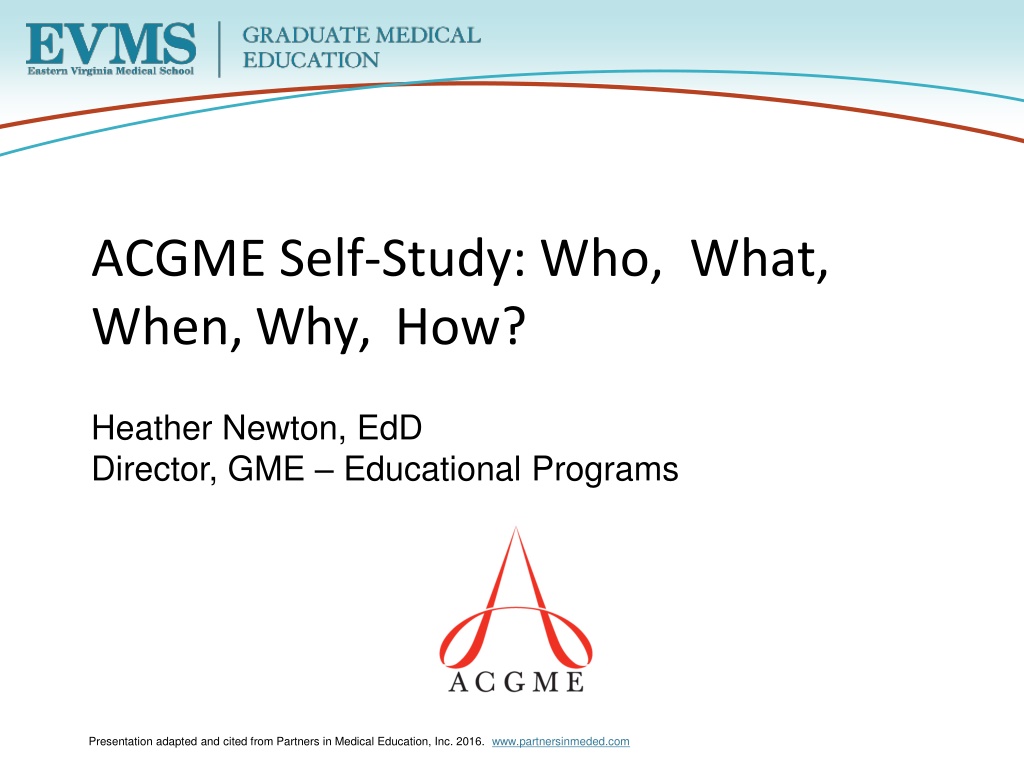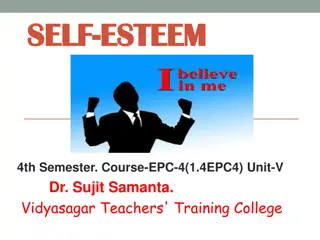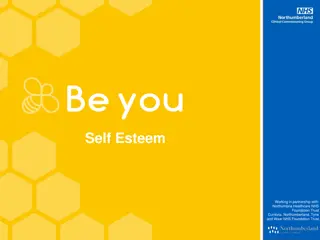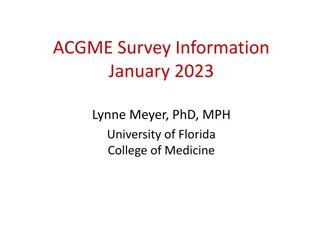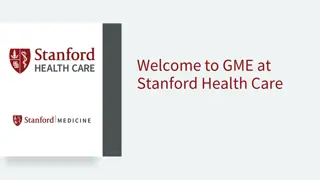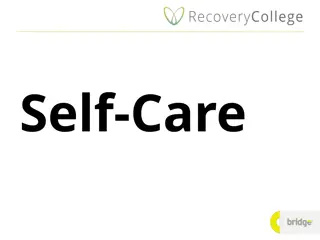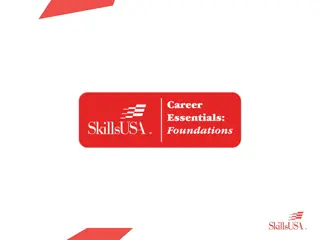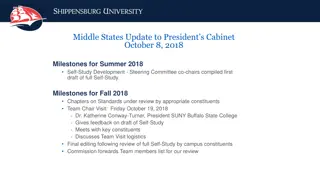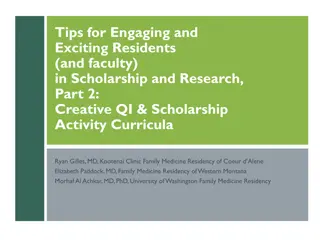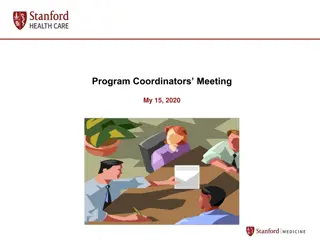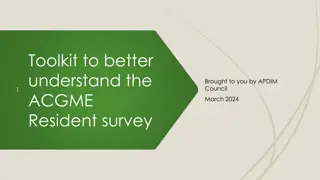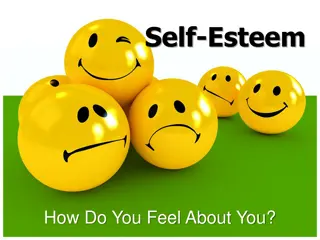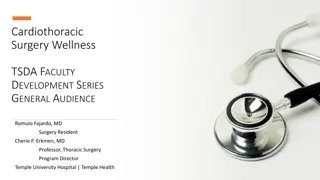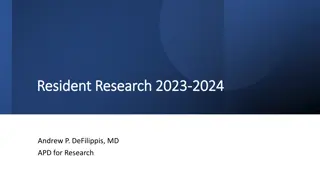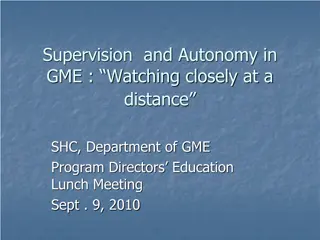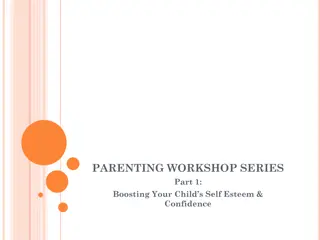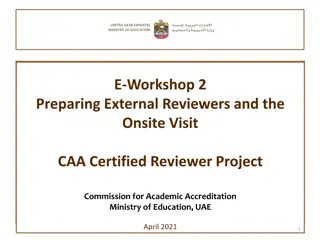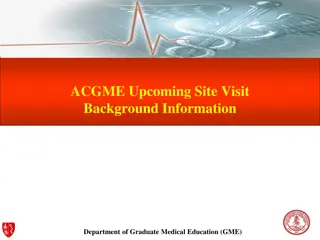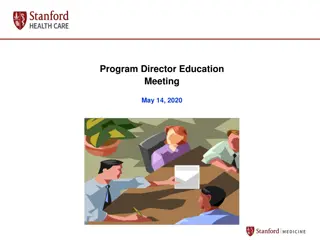ACGME Self-Study: Process, Purpose, and Implementation
Explore the rationale and process behind ACGME self-study initiatives, emphasizing improvement, community analysis, and goal-setting. Learn how to conduct a self-study, from forming committees to final submission, with a sample timeline and focus on SWOT analysis.
Download Presentation

Please find below an Image/Link to download the presentation.
The content on the website is provided AS IS for your information and personal use only. It may not be sold, licensed, or shared on other websites without obtaining consent from the author. Download presentation by click this link. If you encounter any issues during the download, it is possible that the publisher has removed the file from their server.
E N D
Presentation Transcript
ACGME Self-Study: Who, What, When,Why, How? Heather Newton, EdD Director, GME Educational Programs Presentation adapted and cited from Partners in Medical Education, Inc. 2016. www.partnersinmeded.com
Goals and Objectives Understand the rationale behind self-study Develop a comprehensive self-study process Analyze and implement self-study findings Presentation adapted and cited from Partners in Medical Education, Inc. 2016. www.partnersinmeded.com 2
Why Do a Self-study? Promote improvement Analyze community needs Comprehensive, longitudinal review of program Set aspirational goals Recognition of meeting requirements Raise the bar beyond minimum standards Presentation adapted and cited from Partners in Medical Education, Inc. 2016. www.partnersinmeded.com 3
Components of Self-Study Assign core self-study committee Determine timeline Work backwards from self-study date Large programs w/subs longer time than smaller programs Determine who (stakeholders) SWOT Data Collection Analysis/Report Self-study summary document Presentation adapted and cited from Partners in Medical Education, Inc. 2016. www.partnersinmeded.com 4
Sample Timeline Self-study date February 1, 2018 August 2017 kick off meeting September 2017 review APE and ADS survey; identify stakeholders; create survey October 2017 SWOT Analysis November 2017 review survey results; develop program aims and activities December 2017 meet with stakeholders; discuss APE process January 2018 develop plans for improvement February 2018 -final review and submission of application Presentation adapted and cited from Partners in Medical Education, Inc. 2016. www.partnersinmeded.com 5
SWOT Strengths, Weaknesses, Opportunities, Threats Weakness = areas for improvement No right or wrong answers Non-punitive Group effort Presentation adapted and cited from Partners in Medical Education, Inc. 2016. www.partnersinmeded.com 6
http://commons.wikimedia.org/wiki/File:SWOT_en.svg. Permission: Creative Commons Attribution-Share Alike 2.5 Generic 7
SWOT Opportunities are external factors that are not in your control. What external changes will bring you opportunities? What are the current ongoing trends? Positive or negative? What are the social and economic conditions? What real opportunities are present today? Is there anything that is going on around you that may be useful? What are some best practices that you can incorporate? What can you do today that is not being done? Who can support you and how? Presentation adapted and cited from Partners in Medical Education, Inc. 2016. www.partnersinmeded.com 8
SWOT Threats are external factors that are not in your control. What are the negative aspects in the current market? Are your key staff members and workers satisfied with their wages and other benefits? Do you see them being poached by your rivals? Do you see a change in resident recruitment? Are any new government regulations going to affect you? What are the chances of a natural disaster affecting your program? Will political instability hurt you? What might cause you problems in the future and how? What is your competition doing that might cause difficulties for you? Do your residents stay in the organization or do they work elsewhere? Presentation adapted and cited from Partners in Medical Education, Inc. 2016. www.partnersinmeded.com 9
Program Aims Aims are general statements Provide shape & direction to the more specific actions designed to achieve some product or behavior. Starting points that suggest some ideal or inspirational vision for the good. Reflect value judgments and value-laden statements. Provide guides for the educational or training process. Educational aims Relevant to the times (present and the future) Have direction that matches community need Do not have to be static Presentation adapted and cited from Partners in Medical Education, Inc. 2016. www.partnersinmeded.com 10
Writing Program Aims Broad goal (objectives get you to the goal) Train individuals to be community physicians and experts in community medicine. Train individuals to be physician-scientists. Train individuals to be experts in population health and practice in medically underserved areas. Train individuals to be academic physicians that practice in large teaching hospitals. Train individuals to be physician leaders. Presentation adapted and cited from Partners in Medical Education, Inc. 2016. www.partnersinmeded.com 11
Writing Program Aims Who is being trained? Resident demographics What do graduates do after graduation? Where they practice What populations does the program serve? Community demographics Presentation adapted and cited from Partners in Medical Education, Inc. 2016. www.partnersinmeded.com 12
Data Data Collection Survey Who to survey? What to ask? Focus group/Meetings Who to meet? What to ask? Frame around aim and educational environment 13
Additional Data Points APE(s) including action plan(s) ADS information Letters of notification Survey results (ACGME & internal) Program, institution, area specific information i.e. new hospital, new residency in area, changing demographics, mergers, etc. Presentation adapted and cited from Partners in Medical Education, Inc. 2016. www.partnersinmeded.com 14
Analyze Core Self-study group Pick key areas Prepare self-study summary Action plan Focus on getting to your aim Focus on improvement Presentation adapted and cited from Partners in Medical Education, Inc. 2016. www.partnersinmeded.com 15
Self-Study Summary On ACGMEwebsite Core Subspecialty Only 8 questions Due by the end of the month of assigned self-study date. Example: Self-study date of June 2017, the summary must be uploaded by June 30, 2017. DIO review Presentation adapted and cited from Partners in Medical Education, Inc. 2016. www.partnersinmeded.com 16
Self-Study Summary Q1: Program description Describe as would to an applicant 250 word maximum Q2: Program aims 150 word maximum Q3: Program activities to advance aims Current or initiated activities 250 word maximum Q4: Opportunities 250 word maximum Presentation adapted and cited from Partners in Medical Education, Inc. 2016. www.partnersinmeded.com 17
Self-Study Summary Q5: Threats 250 word maximum Q6: APE process Aggregation of information; tracking of action plans 250 word maximum Q7: Self-study process Who, data used, how analyzed, prioritization of improvement areas, other information 450 word maximum Q8: Learning that occurred during self study Optional (but recommended) 250 word maximum Presentation adapted and cited from Partners in Medical Education, Inc. 2016. www.partnersinmeded.com 18
Implement Action Plan AY2015-2016 Item or Intervention Date & Responsible Person Expectations Outcomes & date Status & date Presentation adapted and cited from Partners in Medical Education, Inc. 2016. www.partnersinmeded.com 19
Lessons learned so far Set deadlines Start early Integrate with APE process Opens discussion Not punitive Faculty development opportunity Presentation adapted and cited from Partners in Medical Education, Inc. 2016. www.partnersinmeded.com 20
Resources ACGME self-study website: http://www.acgme.org/What-We- Do/Accreditation/Self-Study-and-Site-Visit Guralnick,S., Hernandez, T., Corapi, M., Yedowitz-Freeman, J., Klek, S., Rodriguez, J., Berbari, N., Bruno, K., Scalice, K., & Wade, L. (2015). The ACGME self-study an opportunity, not a burden. Journal of Graduate Medical Education, 7(3), 502-505. doi: http://dx.doi.org/10.4300/JGME-D-15-00241.1 Sathidevi.V.K., & Sividas.M.G. (2013). SWOT analysis of medical education and training in government medical college, Kerala, India. International Journal of Scientific and Research Publications, 3(3), 170-175. Available at http://www.ijsrp.org/research-paper-0313/ijsrp-p1532.pdf. Presentation adapted and cited from Partners in Medical Education, Inc. 2016. www.partnersinmeded.com 21
